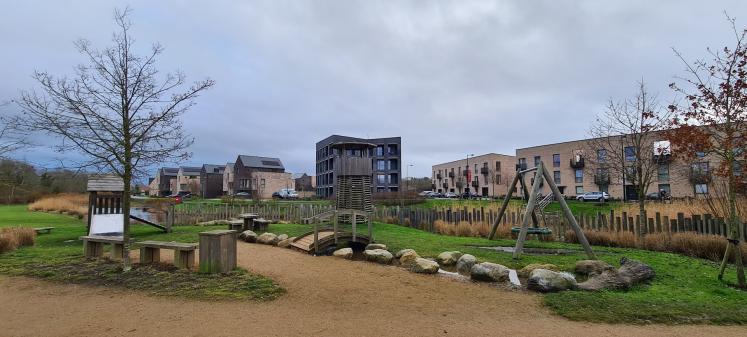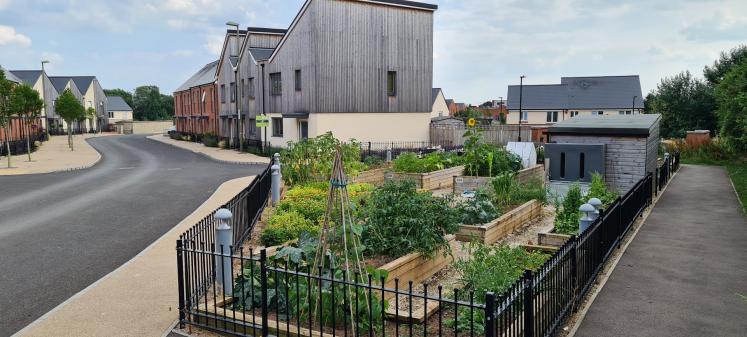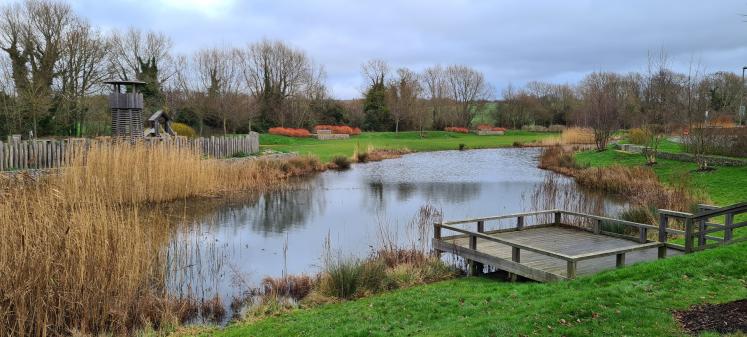The built and natural environment
Healthy place shaping seeks to design health into the urban environment, enabling residents to become active, connect with their neighbours, and access nature in the green spaces around them.
Healthy homes
We need affordable, good quality, secure housing. When homes are poor quality, unaffordable or we experience overcrowding they are a threat to our health and wellbeing. Measures that can help reduce risks to health which also address other challenges such as climate change include:
- design of homes to ensure they are resilient to heat and cold
- home adaptations to support independent living
- home improvements to address existing poor quality housing stock
- more secure private tenancies
- investing in the supply of affordable homes.
The pandemic highlighted the role housing plays in health with poor housing conditions associated with a greater spread of the coronavirus and people experiencing overcrowding and no access to outdoor space finding it hard to cope with the social impacts of lockdown.
Oxfordshire County Council and Oxfordshire Clinical Commissioning Group are funding a pilot project which seeks to address the housing needs of people living in poor-quality homes in Oxfordshire.
20-minute neighbourhoods

The 20-minute neighbourhood is a model of urban development that creates neighbourhoods where daily services can be accessed within a 20-minute walk. The idea is supported by the Royal Town Planning Institute and the Town and Country Planning Association in the UK.
The aim is to regenerate urban centres, enhance social cohesion, improve health outcomes and support the move towards carbon net-zero targets through increasing active travel.
20-minute neighbourhoods need to:
- be safe, accessible and well connected for pedestrians and cyclists
- offer high-quality public realm and open spaces
- provide services and destinations that support local living
- facilitate access to quality public transport
- deliver housing/population at densities that make local services and transport viable
- facilitate thriving local economies
Oxfordshire County Council is working with district and city councils to ensure that regeneration schemes and new developments support the application of the 20-minute neighbourhood model to create walkable, vibrant neighbourhoods.
Active and sustainable travel
Oxfordshire’s Local Transport Plan vision is for a net-zero Oxfordshire transport system that seeks to reduce the need for travel, secures high-quality gigabit connectivity, and discourages unnecessary individual private vehicle use through making active travel, public and shared transport the natural first choice.
The pandemic has brought unprecedented urgency to increase the proportion of residents choosing active and sustainable travel. Oxfordshire has secured funding from the Department for Transport’s emergency active travel fund to increase cycling and walking in Oxfordshire, through infrastructure improvements and a range of complementary measures.
The aim of this work is to reduce traffic congestion and its associated problem of poor air quality and to improve health and wellbeing.
Active travel can contribute to the 150 minutes of physical activity recommended for adults each week. Building a walk or cycle into daily routines is a sustainable and effective way of increasing activity levels but activation measures are needed to support this behaviour change. Further information about the active travel programme.
The evaluation of the Cycling and Walking Activation programme demonstrated that the interventions increased modal shift and encouraged people from more disadvantaged communities to cycle and walk more.
Healthy food environments

Oxfordshire’s Health Improvement Board has identified reducing obesity as one of its key priorities.
Food environments are a combination of the ‘spaces’ in which people make decisions about food and the foods and drinks that are made available, accessible, affordable and desirable in those spaces.
Creating sustainable food systems with a focus on increasing local outdoor spaces for growing food and developing local supply chains are important enablers for people to be able to easily access affordable healthy food and eat well.
Equally, we need to address characteristics of urban areas such as the number, density and location of fast food outlets which can increase the risk of becoming an unhealthy weight.
Local planning policies need to reflect these ambitions to improve the availability and accessibility of healthier food options and we are working with district and City planning authorities to ensure that these are included in future local plans.
Health and planning
Public health and planning share the same roots – both professions emerged from a desire to create places that would support good health.
Healthy place shaping seeks to return to this more integrated way of working, with public health and NHS colleagues working much more closely with planning officers to design health into communities and to ensure that they have the health and care facilities to meet the needs of the local population.
Local planning authorities are required to engage with wider health and social care partners including primary care, CCGs, STPs/ICSs and NHS trusts and should specifically refer to local health needs evidence when developing their local plans/local development plans.
The National Planning Policy Framework (NPPF) highlights that the planning system can play an important role in facilitating social interaction and creating healthy, inclusive communities by setting out the wide-ranging ways in which planning should promote healthy, inclusive and safe communities (Chapter 8).
National Planning Practice Guidance (PPG) expands on the NPPF and notes that local planning authorities should ensure that health and wellbeing are considered in local and neighbourhood plans and in planning decision making. Planning should aim to promote healthy communities which are places that are good to grow up and grow old through the support of healthy behaviours and reductions in health inequalities.
Planning tools
Several planning tools can help to ‘put health into place’ including:
- New guidance is available to people developing neighbourhood plans. OCC’s Public Health team has worked with the Oxfordshire Neighbourhood Plan Association (ONPA) to produce guidance on how to include health considerations in the neighbourhood plan process. Information on the guidance can be found on the ONPA website
- New topic paper on healthy communities provides background information on the subject of strong and healthy communities to support the development of Local Plans, AONB Management Plans and Neighbourhood Plans. Developers will also find it a useful source of information as it outlines the healthy place shaping principles that should be applied when designing new housing schemes. Healthy Place Shaping Update - September 2023 (docx format, 924 KB)
- Oxfordshire’s Joint Strategic Needs Assessment now includes information, links and downloads for local indicators related to Healthy Place Shaping. If you are planning to assess the health impact of a proposed development, please use the Oxfordshire HIA toolkit and data contained within the JSNA to understand the health and wellbeing needs of the local population to identify how a scheme might impact on local needs. Such assessments will need to consider how any development will impact on and seek to reduce health inequalities, for further information please access the Oxfordshire Local Area Health Inequalities Dashboard.
- Exemplar healthy place shaping policy (docx format, 25Kb) as a guide for local planning authorities to include in their Local Plans
- Building for a Healthy Life: A Design Code for neighbourhoods, streets, homes and public spaces 2020 (pdf format) is Homes England’s key measure of design quality.
- The National Design Guide sets out the characteristics of well-designed places and demonstrates what good design means in practice.
- Health impact assessments enable developers to consider health and wellbeing needs at the earliest master planning stage to ensure that development addresses local health needs, maximises the health benefits and mitigates any potential harms. Oxfordshire Future Partnership (a partnership of all the planning authorities in the county) has produced a local health impact assessment toolkit to assist planners and developers to use HIAs as part of the development process. Oxfordshire health impact assessment toolkit.
- Oxfordshire Public Health team has produced a Local Plan Review Framework (docx format, 24 KB) to help Planning Policy Officers understand how public health will review draft Local Plans and Health Impact Assessments of Local Plans. The review framework aims to assist planners in understanding the policy areas that are particularly relevant to how Local Plans can promote health and well-being.
- The National Planning Policy Framework (NPPF) highlights that the planning system can play an important role in facilitating social interaction and creating healthy, inclusive communities by setting out the wide-ranging ways in which planning should promote healthy, inclusive and safe communities (Chapter 8).
- National planning practice guidance (PPG) notes that local planning authorities should ensure that health and wellbeing are considered in local and neighbourhood plans and in planning decision making. Planning should aim to promote healthy communities which are places that are good to grow up and grow old through the support of healthy behaviours and reductions in health inequalities.
Access to nature

Access to the natural environment, open spaces, parks, rivers and canals and the countryside is important for both mental and physical health. Access to, along with the means and ability to engage with green places, has been identified as being a key determinant of physical health and mental wellbeing. Lack of access to green and blue spaces has shown to have contributed to inequalities throughout the pandemic and continues to do so.
Green spaces, places and nature need to be designed and built into the housing, living spaces and towns so that everyone has access, and this is facilitated and encouraged through projects that address barriers to access and connectivity.
Clean air
Taking 672 million breaths over the average lifetime means clean air is one of the key building blocks to living your best life, free from ill health and reaching your potential. Dirty air impacts all stages of life, from birth, where dirty air can cause low birth weight, the development of asthma in childhood to aging with longer health conditions like cardiovascular diseases (strokes and heart attacks) and COPD. More information on the health effects can be found in the Bitesize on air quality on the council’s data pages.
Air pollution comes from a range of sources in our communities, heating our homes, including woodburning stoves, transport, industry and agriculture. Indoor air pollution can also impact health, for example through homes with mould and damp, smoking, cooking and products like candles and cleaning products. Besides local manmade sources of pollution, air pollutants travel long distances occur naturally occurring like dust from desert storms, wildfires and volcanic eruptions, or pollen from plants and trees.
The County Council has developed an Air Quality Strategy (pdf format, 3.3Mb), and one-page summary (pdf format, 198Kb) and visual summary (pdf format, 371Kb) for the council whose vision is “to accelerate the improvement in Oxfordshire’s air quality to reduce the health and environmental impacts of dirty air, so ensuring that all residents can breathe safely.” The intention is to build on the statutory duties of District and City councils to monitor for UK legal limits and to ensure good air quality is maintained and improved. A route map (pdf format, 1.4Mb) outlines the key actions we will be taking over the next three years.
If you’re curious to find out more, head over to the Oxfordshire Air Quality website where you can find out local air pollution levels or check out your air pollution footprint.
Health care facilities
When designing new developments or seeking to regenerate an area it is important to provide convenient and equitable access to health facilities and services – health centres, community hubs, community voluntary sector organisations, GPs, dentists, pharmacists, sports and leisure facilities to meet current and future population needs whilst also promoting self-care and prevention of ill health.
These facilities need to reflect new and innovative models of health and care services and social infrastructure so that they reflect the move to increase provision of support online and a more integrated way of providing local health services so that they link in better with community assets.